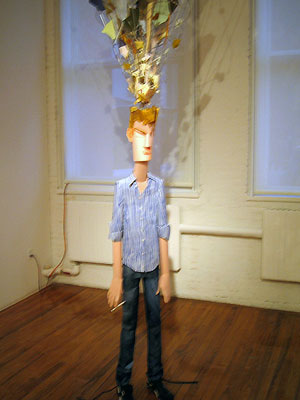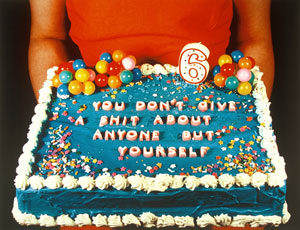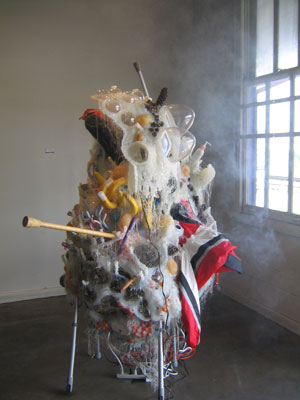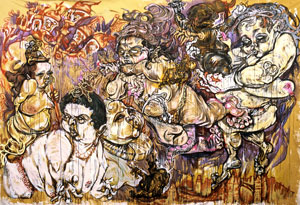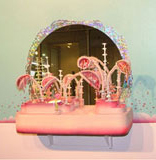Given the fact that there have been other attempts at big serial shows in Texas before, few of which have lived to see another incarnation in the promised two or three years, it’s understandable that we all greeted the latest and greatest Texas Biennial, thrown together by a somewhat ragtag group of Austin art spaces, with skepticism.
But even though the exhibited results were a little uneven, shame on us for our jaded, lukewarm reception to the idea. For the latest Big Texas Serial Show demonstrated a joyful embrace of everything we love about the visual arts in Texas — generosity of spirit, wildcatter chutzpah, and a dash of smart sophistication (as in the press packet of four-color, oversized postcards of each artist’s work, with the artist’s contact information — a nice touch which you wouldn’t have seen in more “professional” settings.)
So while we reserve our utter approbation until the wrinkles get smoothed out, the quality control gets…more under control, and until the Texas Biennial happens again in a couple of years, we nonetheless have to salute the grit of the shows’ organizers. Texas needs a homegrown art extravaganza, as much as it needs all the fancy museums that get the state on the map elsewhere. And (it must be noted), the organizers of this “Biennial” chose the name with deliberate cheekiness: they never intended it to be the be-all, end-all of Texas art.
So in the spirit in which it was mounted, here’s to hoping the Texas Biennial lives long and prospers. But even if it doesn’t, someone else will come up with another loftily-named show in a few years to take its place. For there have been other, completely unrelated Texas Biennials in the past. The Contemporary Arts Museum in Houston had a Texas Triennial in 1988, and the now-defunct Dallas organization DARE had a Biennial in 1993, neither of which were repeated. In the catalog for this latest Biennial, juror and Glasstire contributor Bill Davenport comments beautifully on this phenomenon: “It’s useful to think of the three shows, in 1988, 1993 and 2005, as a continuous tradition: a bipolar history in which peaks of ambition trail off into troughs of apathy only to regenerate again with new players. It’s the classic boom-and-bust cycle…. Here in Texas we have a hierarchy of energy: whoever will make the effort, gets the goods.”
Too true. – Glasstire Eds.
The idea was planted one very hot day in May 2004 when Arturo Palacios, Dougherty Arts Center director, and Jon Lawrence, Eastside Artists Co-op representative, sat in Jon’s truck talking about putting together a statewide call for entries show. It wasn’t until they joined with East Austin Studio Tour (EAST) organizers Jana Swec, Joseph Phillips and Shea Little of Bolm Studios, and Camp Fig gallery director Michael Sieben that they learned their show could be a Texas Biennial. Gallery Lombardi director Rachel Koper, an Austin stalwart whose energy and commitment to the emerging art scene in Austin cannot be overstated, completed the group — though prominently missing was The Fresh Up Club, a small warehouse space in Austin’s East Side.
“Death by Slides”
15 jurors including three artists and a dozen gallerists — five from Austin, two from Houston, and one each from Lubbock, San Antonio, Corpus Christi, El Paso and Arlington, viewed 3,000 slides from 670 artists in 99 Texas cities. The jurors narrowed that to 100 artists and 300 pieces the first day of judging. By the end of the grueling second day at the Dougherty, the numbers were down to the final 36 artists and 70 pieces.
Sara Kellner, Director of DiverseWorks and a juror in the show, said she’d never been on panel with so many artists: “So many panels are just a bunch of curators, and artists are looking at the work from the point of view of the maker, and they are intimately related to the other artists on a lot of levels so the dialogue was different, and less restrained. Curators feel like they have to be polite.” Kellner commented that the atmosphere was fun, with plenty of food and beer and “the kind of conversation you have at a really good dinner party.”
Was there compromise? The old “but we only had slides to go by!” defense always rings hollow until you yourself have to sit on a panel and try to figure out what someone’s work looks like based on a gritty transparency. With slides, there’s always compromise — the deck is stacked against you as a curator, and with that kind of curatorial process there will always be a level of unevenness.
The venues
We visited Austin at the end of opening week, starting early at Dougherty Arts Center south of downtown. It was a sharp contrast from that wide, soft community space to Camp Fig on parking-challenged upper downtown Austin’s crowded Sixth Street.
I was eager to get out of close, little Fig, the funkiest, clunkiest space — tiny, crowded and busy with pushily aggressive art like Tara Welch‘s angry phrase-decorated cakes; Celia Eberle‘s enigmatic appliqué, which had shown previously at Mulcahy Modern Gallery; Richard Martinez’s blue, swampy, shaped canvas; and Patricia Donahue’s angry figure in haywire woods.
We awarded Bolm Studios our favorite venue. Not just because it was difficult to find; the map was fine. We just couldn’t believe that cluttered blockhouse was an art gallery. But it had the best, most cohesive work inside, and lots of funky artist charm outside.
The cleanest, best lit of the venues was the Eastside Artist Co-op on Cesar Chavez Street in colorful East Austin. Inside the spacious rooms of this cute shotgun-house-cum-gallery were esoteric art ideas, including Sci-Fi gun art by Daniel Tackett; vivid calligraphic Iris prints by Chris Ferebee; eloquent negative space abstracts by Lance Jones; and crocheted mounted deer heads by Elaine Bradford, which we liked, then disliked in rapid succession.
Gallery Lombardi, by the tracks in deepest downtown where the street disappears into potholes and mud, was the final opening. The art and activity inside and on the loading dock reminded us of the close community of the old 500X in Dallas, before they took up the tracks, so the train didn’t screech by anymore.
Lombardi was where a guy who”d been riding around on his bike all day in the guise of The Invisible Bicycle — clear plastic shirt and pants over white underwear briefs — fit right in with Mari Omon’s haunting tea-bag cloud, though the installation overall was terribly cluttered; Rosalyn Bodycomb‘s somber grayscale paintings; Jimmy Kuehnle’s Invisible Bike, which he rides every First Friday in San Antonio; and Matthew Rodriguez” unconventional Kitty Sees Things painted on the bottoms of six rectangular cake pans, which had shown previously in the show Painting Attack at the Dallas Center for Contemporary Art.
The Art
The first piece that wowed us was Jerry Chamkis” Kosmophone, which translates cosmic rays into ambient music. He had a long explanation posted, but trust me. Technically art, yet perceptible in different dimensions. Eloquent audio outside the box; high tech knobs and glowing tubes inside.
Dimensionality may be one of the more important sub-themes at the show.
I did not like William Betts” striped Take my breath away acrylic when I first saw it — oh, another Bridget Riley rip, I thought mindlessly. Then I started looking at it to see how it accomplished its 3-D magic. It is flat. But I had to look down at it at close range to trust its strong optical approximation of shape was sham. I found myself comparing Betts” piece with others that deal with the elusive third dimension in subtle ways, and it fits right in the category.
Christine Gray’s Forest Compression oil of a partially collapsed card tree, having lost in that compression most of its dimensional extension, toys with our sense of space. It’s a tree, no doubt, but though we recognize its component parts, we do not see much of its tree-ness. Upon close inspection, the green plant in Gray’s other oil exhibits its pinned-together paper clover composition, further confounding our assumptions of dimensionality.
There’s a remarkable similarity between Annie Simpson’s wide, pixelated cosmic Since There Are No More Stars oil at Dougherty and the long, soft-colored strips comprising Young-Min Kang‘s giant, room-filling traffic sculpture at Bolm. Kang’s careful Interstate Junction of overpasses entirely comprises single-pixel strips of color tones mounted on chicken wire rails, and it knocked our collective lights out. There was competition, but this was the most jaw-dropping piece we encountered at any of the five venues. It was also the biggest. Up close, it seems a storm of abstract pastel squares. With distance the image coalesces.
Another remarkable similarity pairs work by Faith Gay and Charlotte Smith. Gay’s Langleybandontherun looks dimensional but is flat, and her nearby cake icing Tarkus has only a fraction of an inch of depth. Smith’s has the same shadows, shapes and colors but her Blue Pile-up and tan Chaos are minutely dimensional, like armies of painted chocolate chips.
I was surprised when I realized the totemed, large faced, myriad-handed clocks and the dual strange, randomizing disk video projection machines in the darkened room at Bolm were by single artist Barna Kantor. The piece had shown in the show Construction Site, but did not show nearly as effectively in the Bolm space as it had previously. Both disparate machines were immediately calming, although many may have thought them off the bleeding leading or trailing edge. Beautiful to ponder then and since, their subtle simplicities stay, their many hands serenely sweep and tick through my daydreams still.
Kantor’s Retinal Massage I’s dual overhead projectors, reflecting beams diffracted through disks circling slowly staccato, up then mirrored to a screen pebbled with overlayed dots of instant and time-delayed patterns. Simultaneously subtle and overt, clunky, svelte and mechanically sly. I liked waving my arms in the path and seeing my motion echo ragged on the screen. If you don’t get physically involved with this sculpture, you miss half the fun.
Serena Lin Bush’s Speak Easy is the piece we kept seeing in the media in Austin, whose large deaf community may understand two floating TV monitors hand-signing in a simple visual, electronic metaphor. Less coherent is the laugh track, which if you don’t know sign (or don’t realize that the two hands are signing Abbot and Costello’s famous Who’s On First routine) doesn’t make a lot of sense.
One of art’s duties is to scare us silly. Frightening us wakes us up to possibilities. Bad art may be the best thing we got going. Or then again, maybe not.
I keep looking at Nina Rizzo’s Lodge acrylic in the lobby at the Dougherty. When I first saw it, I saw only those Brillo bits of reddish-orange smudges. Like a blot on sunglasses, I want my mind to tune it out. With the Brillo gone, I could enjoy this optically delusional architecture zooming through painterly space in exaggerated 3-D colors. I like the random streaks of contrasting colors and thick brush strokes. It is a small painting, and a similar one nearby was easier to enjoy, but this one’s postmodern pile-up of images and unironic juxtapositions make me want to like it, but I can’t not look at the Brillo glitz.
It’s not difficult to understand how someone who likes Matthew Guest’s large and grandiose Sick-Sixty-Sick acrylic would also like Ali Fitzgerald’s Blubbering Heights. It’s hard to imagine work like these are avant again, but the art world keeps going around. Fitzgerald’s horrific vision wants us to look away in disgust, and I did. Then I looked back. It’s easy to dislike art that offends. Gloomy grotesqueries combine with a vivid palette to turn our stomachs, then sneak looks back to see why. Look away, talk nervously, then return to the scene of crime against aesthetics.
We barely noticed Jonathan Marshall’s giant Eruption of Mount St. Helens, 1980 drawing until the founders gathered in front of it to announce the Juror’s Choice Best in Show $1,000 award at the top of the opening at Gallery Lombardi Saturday night. All the amazing art running loose in this diverse competition and the full jury overwhelmingly chooses this as its best? Nice enough for what it is, a monochromatic comixish illustration. What it doesn’t show is deep thought, unique expression, fine drawing, impending doom, threat, scariness, or even a great job at rendering smoke.
At the end of the day, the Texas Biennial was a jumble of art spaces showing work that veered between the unjustifiable and the sublime. May it come again in two years, and may it stay true to its plucky grassroots origins, always.
Images courtesy of Texas Biennial website, and Arturo Palacios.
JR Compton runs the website Dallas Arts Revue, where this review originally appeared.


